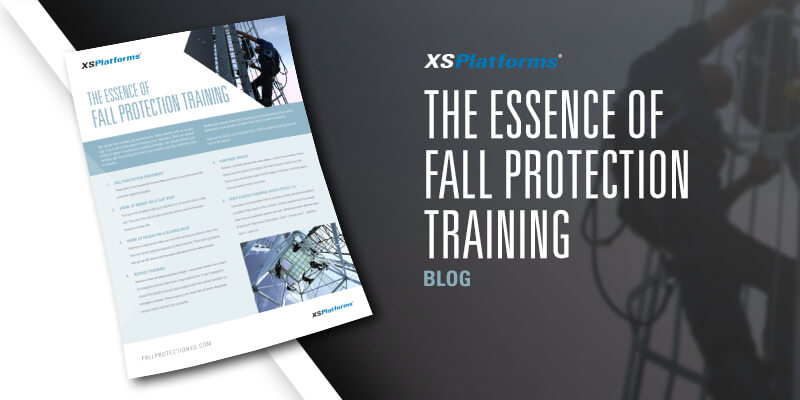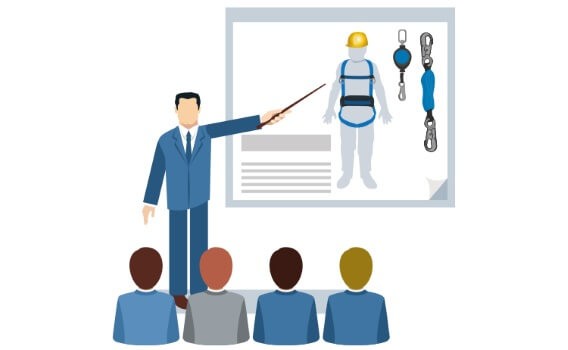
It is a well-known fact that working at height is not without any danger. Regrettably, many people all over the world still get seriously injured or fatally wounded after a fall from height. Lack of knowledge, improper use of equipment or underestimation of the risks often cause dangerous situations. Situations that can be avoided if all those working at height are properly trained and regularly retrained.
Most countries have regulations that require employers, or building owners, to provide fall protection for work at height. This includes training as those at height have to be competent and understand the dangers of their workplace and the measures to ensure their personal safety. Anyone without proper knowledge can make dangerous mistakes that could cause harm to themselves, others or the structure.
Therefore, anyone working at height should be trained in risk recognition, fall protection measures, correct usage and maintenance of fall protection equipment and rescue procedures in case of a fall.

Risks
Before any work at height is executed on a location a risk assessment needs to be carried out. This assessment shows what measures and equipment need to be implemented to keep those at height safe.
Workers also need to be trained to recognize these risks. Knowing the different risks associated with working at height means people are aware of the potential fall hazards they are exposed to. This prevents risky behavior, such as overreaching or stepping onto a surface that may not be safe.
System components
Knowing the parts of a fall protection system and their functions will help workers understand how a system is supposed to keep them safe. Not to mention should they notice an element is damaged they can report this and prevent an incident.
For example all lanyards for fall arrest purposes should be equipped with a personal energy absorber (PEA). This is to protect the body of the user in case a fall occurs. Training specific to the worksite helps educate workers on how to keep themselves safe.

Maintenance
Additionally training should discuss the need for maintenance and inspection to the fall protection equipment. Next to annual inspections, anyone using Personal Protective Equipment (PPE) for fall protection must inspect their gear before starting work. During training workers should learn what damages and deformations to look for. The same goes for the fall protection equipment, such as an anchor point on a roof.
Hands-on
Learning-by-doing helps people take in knowledge better. Therefore hands-on training on the use of fall protection equipment, such as the right way to connect to an anchor point, helps workers retain know-how. Make sure that the training includes exercises for all the fall protection equipment and Personal Protective Equipment workers are expected to use.
Hands-on training ensures correct equipment usage in the future. However, it is important to offer refreshing courses or toolbox talks to ensure workers don’t get careless.
XSPlatforms often works with HLL systems with XSBending kits, these are patented posts that bend in the direction of a fall and increase the sag angle, thus decreasing the loads exerted on an anchor. Another form of integrated energy absorption is the XSDynamic, this extends the cable trajectory, catching most of the blow. A combination of both energy absorbers can also be made to accommodate more users.

Rescue
Last but not least, training should address rescue. Of course we all want to assume no one will fall, but if someone falls all people on site need to know what actions to take. Hanging in suspension is not a pleasant matter and poses risks to your health. (Read more about this in our blog on Harness Suspension Trauma). For that reason rescue needs to occur quickly.
Download training brochure
No matter how reliable fall protection equipment is, safety stands with its correct use. Effective training helps create a safe workplace. Learn about the different training possibilities by downloading our brochure.

1 Comment. Leave new
I like that you pointed out how additional sessions should be provided regarding working safely at heights training which will include the maintenance and inspection of the fall protection equipment aside from getting an annual inspection and checking their PPE and gear before they work. I can imagine how these things can definitely help lawyers and their employees in a way that they can be protected and they can avoid any instances of accidents. In my opinion, it doesn’t really matter how high their task is going to be, since it can definitely lead to injuries or even fatalities which is why it is paramount that establishments or industries with workers that are directly working on those kinds of tasks should be trained regularly. https://www.inls.com.au/training-course-calendar